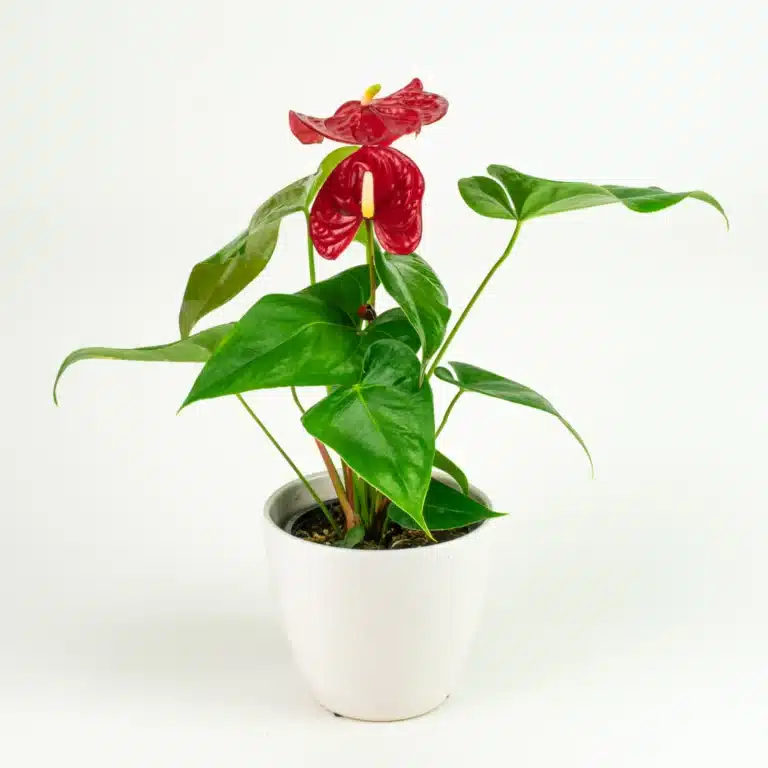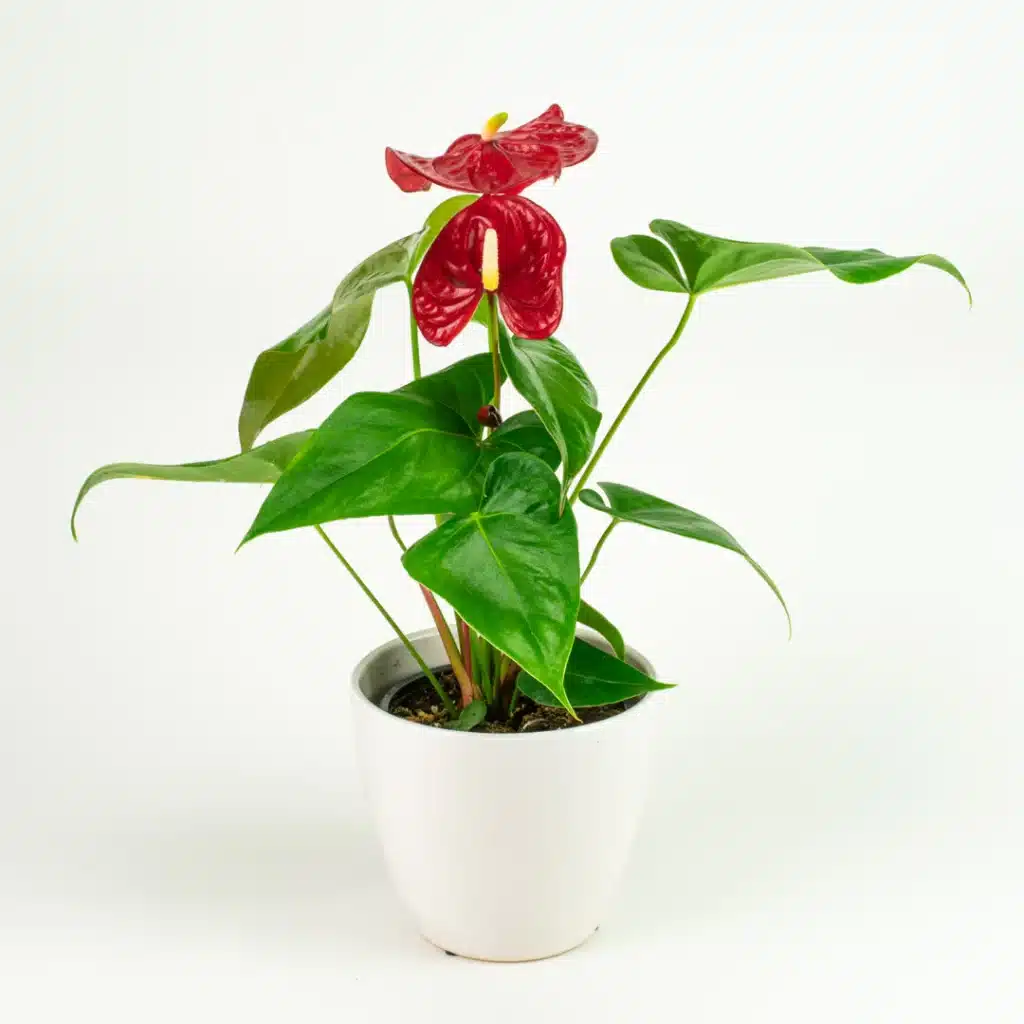Table of Contents
Introduction
Anthurium, commonly known as the flamingo flower or laceleaf, is a striking tropical plant cherished for its vibrant blooms and glossy foliage. Belonging to the Araceae family, Anthuriums are native to the rainforests of Central and South America. With their distinctive heart-shaped flowers in shades of red, pink, white, or orange, Anthuriums add a touch of exotic beauty to any indoor space. These resilient plants thrive in well-draining soil and bright, indirect light, making them popular choices for indoor gardens. With proper care and attention, Anthuriums can reward growers with continuous blooms and lush foliage, making them a delightful addition to any plant lover’s collection.
Exploring 4 Varieties of Anthurium Plants
Anthurium andraeanum: Known for its classic heart-shaped, glossy red flowers.
Anthurium scherzerianum: Commonly called the “flamingo flower,” with vibrant spathes in shades of pink, orange, or white.
Anthurium crystallinum: Characterized by its striking veined leaves resembling works of art.
Anthurium clarinervium: Enchants with its velvety, heart-shaped leaves veined in silver.
How to Grow and Care for Anthurium Plant
Growing and caring for Anthurium plants requires attention to their specific needs to ensure they thrive. Here’s a guide on how to do it:
Light: Provide bright, indirect light for Anthurium plants. Avoid direct sunlight, as it can scorch their leaves.
Temperature: Maintain a warm, humid environment for optimal growth. Anthuriums prefer temperatures between 65-80°F (18-27°C).
Watering: Water Anthurium plants thoroughly but allow the top inch of soil to dry out between waterings. Overwatering can lead to root rot, while underwatering can cause wilting.
Humidity: Anthuriums thrive in high humidity. To increase humidity, mist the leaves regularly or place the pot on a tray filled with pebbles and water.
Soil: Use a well-draining potting mix rich in organic matter. A mix of peat moss, perlite, and pine bark works well.
Fertilization: Feed Anthurium plants with a balanced, water-soluble fertilizer every 4-6 weeks during the growing season (spring and summer). Reduce feeding in fall and winter.
Pruning: Remove dead or yellowing leaves and spent flowers regularly to encourage new growth and maintain plant health.
Repotting: Repot Anthurium plants every 2-3 years or when they outgrow their pots. Choose a slightly larger pot and fresh potting mix.
Pests and diseases: Keep an eye out for common pests like aphids, mealybugs, and spider mites. Treat any infestations promptly with insecticidal soap or neem oil. Anthurium plants are susceptible to root rot, so avoid overwatering and ensure good drainage.
By following these care tips, you can enjoy healthy and vibrant Anthurium plants in your home or garden.

9 Steps for Propagating Anthurium Plant
Propagating Anthurium plants can be done through several methods, including division, stem cuttings, or seeds. Here’s a step-by-step guide for propagating Anthuriums through stem cuttings:
Selecting a healthy parent plant: Choose a mature Anthurium plant with strong, healthy stems and leaves for propagation.
Preparation: Prepare a clean, sharp knife or scissors, and have a small pot filled with a well-draining potting mix ready.
Identifying a suitable stem cutting: Look for a stem with at least two nodes (where leaves emerge) and a healthy growth tip. The cutting should be around 6 inches long.
Taking the cutting: Make a clean cut just below a node using the sterilized knife or scissors. Ensure the cutting has at least one or two leaves attached.
Treating the cutting: Optionally, dip the cut end of the stem in rooting hormone powder to encourage root growth.
Planting the cutting: Insert the cutting into the prepared potting mix, ensuring that at least one node is buried beneath the soil. Gently firm the soil around the cutting to provide support.
Providing optimal conditions: Place the pot in a warm, humid environment with bright, indirect light. Maintain consistent moisture in the soil, but avoid overwatering to prevent rot.
Monitoring growth: Keep an eye on the cutting for signs of new growth, such as roots emerging from the buried node and fresh leaves developing.
Transplanting: Once the cutting has developed a healthy root system and new growth, it can be transplanted into a larger pot with standard Anthurium care.
By following these steps, you can successfully propagate Anthurium plants from stem cuttings, expanding your collection or sharing the beauty of these tropical gems with others.
7 Benefits of Anthurium Plant
Anthurium plants offer a range of benefits beyond their aesthetic appeal:
Air purification: Anthuriums are known for their ability to remove toxins such as formaldehyde, xylene, and ammonia from the air, thus improving indoor air quality.
Humidity regulation: These plants release moisture through their leaves, helping to increase humidity levels in indoor environments, which can be beneficial for respiratory health, especially in dry climates or during the winter months.
Stress reduction: Studies have shown that interacting with indoor plants like Anthuriums can reduce stress levels and promote a sense of well-being, making them excellent additions to home and office spaces.
Enhanced focus and productivity: Bringing nature indoors with Anthurium plants can help boost concentration and productivity, making them ideal companions for workspaces or study areas.
Long-lasting blooms: Anthurium flowers can last for several weeks to months, providing long-lasting beauty and color to indoor spaces without the need for frequent replacement.
Low maintenance: Anthuriums are relatively easy to care for, requiring minimal attention compared to other flowering plants. With proper care, they can thrive and continue to adorn your space with their vibrant blooms and glossy foliage.
Versatility: Anthuriums come in a variety of colors, shapes, and sizes, making them versatile plants that can complement a wide range of interior design styles and preferences.
Overall, Anthurium plants offer not only visual delight but also tangible health and wellness benefits, making them popular choices for indoor gardening enthusiasts and anyone looking to improve their living or working environment.
Common Pests
Anthurium plants, like many indoor plants, can be susceptible to certain pests. Here are some common pests that may affect Anthuriums:
Aphids: These small, soft-bodied insects feed on the sap of plants, causing leaves to become distorted and yellowed. They can also secrete honeydew, leading to the growth of sooty mold.
Mealybugs: Mealybugs are small, white, cottony insects that feed on plant sap. They often congregate in leaf axils and other hidden areas, causing stunted growth and leaf yellowing.
Spider Mites: These tiny arachnids feed on plant juices, causing stippling, yellowing, and eventually leaf drop. They produce fine webbing, particularly on the undersides of leaves.
Scale Insects: Scale insects appear as small, raised bumps on stems and leaves. They feed on plant sap and can cause leaf yellowing, wilting, and stunted growth. They also secrete honeydew, attracting ants and promoting the growth of sooty mold.
Thrips: Thrips are tiny, slender insects that feed on plant tissues, causing silvering, stippling, and distorted growth. They can also transmit viruses to plants.
To manage and control these pests on Anthurium plants, you can use a combination of cultural, mechanical, and chemical methods. These include:
- Regularly inspecting plants for signs of pests.
- Pruning and removing affected plant parts.
- Washing plants with a gentle stream of water to dislodge pests.
- Introducing natural predators like ladybugs or predatory mites.
- Using insecticidal soap, neem oil, or horticultural oils to control infestations.
It’s essential to monitor Anthurium plants regularly and take prompt action at the first sign of pest activity to prevent widespread damage.
Common Problems
Anthurium plants are generally hardy, but they can encounter some common problems that may affect their growth and appearance. Here are a few issues you might encounter with Anthurium plants:
Yellowing leaves: Yellowing leaves on Anthuriums can be caused by various factors, including overwatering, underwatering, excessive sunlight, or nutrient deficiencies. It’s essential to check the plant’s watering schedule, light exposure, and nutrient levels to address the underlying cause.
Brown leaf tips: Browning leaf tips are often a sign of low humidity or inconsistent watering. Ensure the plant is in a humid environment, and water it regularly to maintain soil moisture levels. You can also place a humidifier nearby or mist the leaves occasionally to increase humidity.
Root rot: Anthuriums are susceptible to root rot if they are overwatered or if they are planted in poorly draining soil. To prevent root rot, ensure the plant’s pot has drainage holes, use a well-draining potting mix, and allow the soil to dry out slightly between waterings.
Pest infestations: Anthurium plants can be affected by common indoor pests such as aphids, mealybugs, spider mites, and scale insects. Regularly inspect the plant for signs of pests, and treat infestations promptly using insecticidal soap, neem oil, or other appropriate treatments.
Fungal diseases: Anthuriums can develop fungal diseases such as leaf spot or powdery mildew, especially in humid conditions. Ensure good air circulation around the plant, avoid overhead watering, and remove any infected leaves promptly to prevent the spread of disease.
Flower or leaf drop: Flower or leaf drop can occur due to stress factors such as sudden changes in temperature, drafts, or inadequate light. Ensure the plant is in a stable environment with consistent temperature and lighting conditions to minimize stress.
By addressing these common problems promptly and providing proper care, you can help your Anthurium plant thrive and maintain its health and beauty. Regular monitoring and attention to the plant’s needs will help prevent problems and keep it looking its best.
FAQs
How often should I water my Anthurium plant?
Water Anthurium plants thoroughly when the top inch of soil feels dry to the touch. Avoid overwatering, as this can lead to root rot. Allow excess water to drain away, and never let the plant sit in standing water.What kind of light does an Anthurium plant need?
Anthurium plants prefer bright, indirect light. Avoid direct sunlight, as it can scorch the leaves. Place the plant near a north- or east-facing window for optimal light exposure.How do I fertilize my Anthurium plant?
Fertilize Anthurium plants with a balanced, water-soluble fertilizer diluted to half strength every 4-6 weeks during the growing season (spring and summer). Reduce fertilization in fall and winter when growth slows.Why are the leaves of my Anthurium turning yellow?
Yellowing leaves on Anthurium plants can be caused by overwatering, underwatering, excessive sunlight, nutrient deficiencies, or pest infestations. Assess the plant’s care routine and environment to identify the underlying cause and make appropriate adjustments.How do I propagate my Anthurium plant?
Anthurium plants can be propagated through stem cuttings or division. To propagate through stem cuttings, take a cutting with at least two nodes and place it in a pot with well-draining soil. Keep the soil moist and provide bright, indirect light until roots develop.What are some common pests and diseases that affect Anthurium plants?
Common pests that may affect Anthurium plants include aphids, mealybugs, spider mites, scale insects, and thrips. Anthuriums can also be susceptible to fungal diseases such as leaf spot and powdery mildew.How do I care for Anthurium plants during the winter months?
During the winter months, reduce watering frequency and avoid fertilizing Anthurium plants. Keep them away from drafts and cold temperatures, and ensure they receive adequate bright, indirect light to maintain growth.
Share this post:




